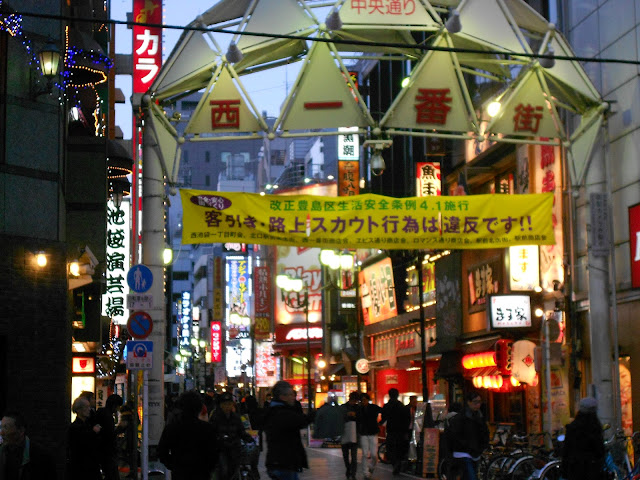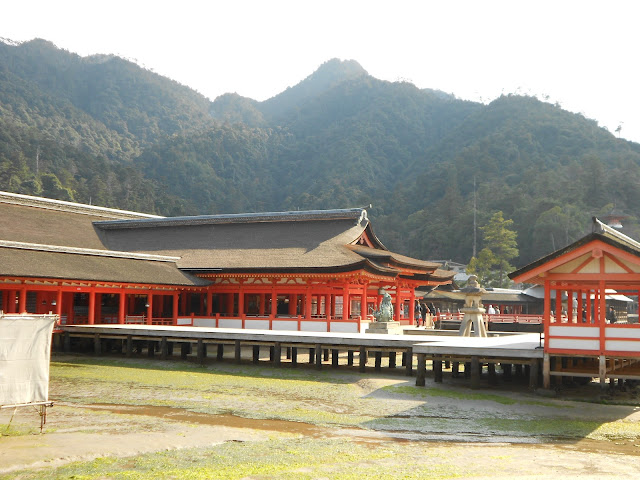Hey guys!
So my last post concluded our stay in Kyoto. When we woke up the next morning, we checked out of the Palace Side Hotel and set off with our baggage to Hiroshima train station.We had packed our carry-on back packs with everything we'd need for an overnight stay and left our suitcases in a Hiroshima train station luggage-locker for the night. We would pick it up the next day on our way to Harajuku, but until then we'd be living out of our backpacks. Once we had stored our luggage, we took the train to Hiroshima to check out the A-bomb dome and Memorial Museum.
 |
| The A-bomb dome. |
 |
| The dome from the other side. |
This trip to Hiroshima was the most serious and emotionally intense leg of our trip. We visited the site where the world's first ever Atomic bomb was dropped and detonated. The explosion killed 66,000 people instantly and critically wounded another 69,000 more. Hundreds of thousands of people suffered the long-term affects of this bomb, either in the form of radiation, burns, complete destruction of their homes or all of the above. Because of the horror of the atomic bomb, the city of Hiroshima has built itself up from the ashes as a city pushing for peace and the abolition of Nuclear weapons throughout the world.
The A-bomb dome was originally a beautiful domed building called he 'Hiroshima Prefectural Productions Exhibition Hall', were business was carried out daily. At 8:15am, August 16th, 1945, the atomic bomb was detonated approximately 600meters above and 160 meters southeast of this building. The explosion killed everyone inside the building instantly, but the ruins were left in tact. This building is the only ruin the was preserved in the destruction of Hiroshima, making it a national landmark and a memorial to all of those lives lost in the explosion.
 |
| Some of the city as seen from a bridge. |
 |
| This memorial statue is for the children who died during and as a result of the bomb. It is based on the story of a girl who developed leukemia due to atomic radiation. She believed that if she folded a thousand paper cranes, her wish to be cured wouldbe granted, but she died before finishing them. This small outdoor exhibit is called the Children's Peace Museum. It is made up of glass cases full of images created by folded paper cranes from children around the world. |
After that, we entered the A-bomb Memorial Museum. The exhibits were all about the history of Hiroshima, Japan's involvement in WWII, the Manhattan Project and the specific effects of the bomb. It was an intense museum to walk through, especially because it not only featured before and after photos and models of the blast, but it has exhibits featuring recovered belongings of specific people who were killed. The whole thing was chilling.
 |
| Photographs of the city taken hours after the blast. |
 |
| One of the models made of destroyed Hiroshima. The whole city was reduced to ash, save for a few skeletons of buildings. |
 |
| A scale model of Hiroshima compared against the size of the fireball created by the bomb. |
 |
| View of modern, rebuilt Hiroshima today. |
When the bomb detonated, it left Hiroshima in ashes, contaminated completely by radiation and and unable to support plant life for a long time. The stories told about people's deaths were deeply upsetting, as a great many of them were children caught in the blast on there way to a school that was right in the major center of the blast area. Out of all the things I experienced in my trip to Japan, this stop was the most humbling.
After we had walked through the entire museum, were set out for the bus that would take us to Miyajima ferry. Miyajima is a small island just off the coast of the main island of Japan. Miyajima is where we would be staying for the night - in a Traditional Japanese Inn! This was the leg of the trip I had been most excited about.
 |
| The view from in front of the mainland ferry station. Get ready for a TON of mountain pictures. I went a little crazy with them on the Island, where the view of the mountains was so perfect. |
 |
| View from the ferry window. See what I mean about the mountains? |
 |
| The great gate of the shire we went to visit on Miyajima. At this tide, the water is just lapping at the bottom of it. At full high tide (which we were unfortunately unable to witness) the whole shrine appears to be floating on the waves. |
 |
| I did warn you. |
 |
| Moutains like this are just too beautiful not to photograph, okay? |
I'll take a brief break from overloading you all with pictures of the shrine and the mountains by telling you about the friend's we made once we got on shore.
 |
| Why hello there. |
Yes, that's a deer. Apparently Miyajima is famous for it's large population of friendly wild deer that roam around town and interact peacefully with the tourists and residents there. They'll come right up to you asking for food, and the'll gladly allow you to pet them. At the time we got there, the town and shrine was full of them, sticking around to score lunch from the abundant amount of willing tourists there. The shrine paid tribute to these deer with several depictions of them at statues and even sewn on to charms.
 |
| Megan feeding a deer. The were very persistent, and would even nose your pockets for food if they were curious enough. |
We feed the deer and had to shake a particularly freiendly group of them off as we approached the Shrine. Itsukushima shrine is one of the most famous and celebrated shrines in Japan. It is settled directly on the water line at such a height that when the tide is at it's highest, the whole shrine is floating right on top of the waves. It's a pity we didn't get to see that particular site, but I did get plenty of cool shots of it.
 |
| First some shrine rooftops. And more mountains. |
 |
| I got distracted from the shrine by the mountains here. Have I mentioned they were really nive to look at? |
 |
| Shrine entrance. You can see the cleansing water here too. |
 |
| Imagine this during high tide. |
 |
| The gate out in the waves. You can also see the mainland city from here. |
After we had seen our fill at the shrine, we finally went to the Inn!
This is was a Japanese traditional style Inn.The rooms were almost entirely traditional with only a few modern updates, (like functional plumbing and a water heater for tea; there was a TV in our room too, but Megan, Kristen and I hid it for the sake of the room looking more authentic.) We would be sleeping on the floor on roll-out futons. We would also be provided a a low tea table on the tatami mats, and with floor slippers to use instead of our shoes, (which should be removed the moment we walked in the door), and with our own yukata (traditional Japanese casual robes) to wear. The Inn even had a hot public bath! On top of all of that, our group would be given traditional Japanese banquet to fully immerse us in the culture.I had been looking forward to this in for months.
 |
| When we got there, we noticed they had put a welcome sign out for us! Everyone took a picture with it. |
 |
| The room Megan, Kristen and I all stayed in! Isn't it nice? Those mats lining the floor are tatami mat. The low tea table was light weight and easy to move when we set up the room for bed. The paper sliding doors provided a really nice soft light in the room. Everything about it was pleasant. |
 |
| See that rond box on the table? That had our tea set in it. We had a tea party later that night. You can also see our little porch area better from this angle. |
The doors to the bathroom and toilet room were behind another set of sliding doors before this room, in the entrance area. The entrance way in also where you took off your shoes and changed into slippers to walk on the mats. We spent a good couple of minutes just 'ooo'-ing and 'ahh'-ing over our room arrangements before we changed into our yukatas and headed downstairs to take advantage of the public bath.
I didn't get any pictures of the bath, for obvious reasons, but the whole experience was like like going to a relaxing spa. The hotel supplied some really nice body soaps, shampoos and conditioners for you to uses at the rinsing stations, which was nice. After we cleaned the travel off of ourselves, we were able to just soak in the bath for as long as we wanted to. It felt awesome on my achy muscles. When we were done, we dried off in the changing room, got re-dressed in our yukatas and went upstairs to get ready for our banquet.
 |
| The blurry picture I took of the three of us in our yukatas. We're in the elevator going down to the banquet. Dr. Huang made wearing the yukata's a required part of the meal. As if there was any other way to enjoy a traditional Japanese feast. |
 |
| The boys in their yukatas. They wore their jackets down too. |
 |
| The banquet hall set up for us! You are supposed to kneel on the mats as you eat. Men are allowed to cross their legs instead if they prefer, and women are permitted to sit "side saddle" on the cushion if they can't handle kneeling. We couldn't cross our legs though - it's seen as rude and very unladylike. |
 |
| Our primary spread! This wasn't even all the food we were given; this is just the appetizers and side dishes. The appetizers shown here included oyster soup, heated and cooked from a candle underneath the pot (top left). We also had sashimi, snail, egg-custard and super-tender beef on this spread. The big brown bowl was full of plain rice. Later, they brought out a salad and the swordfish fillet main course. For dessert we got a small plate of fresh fruit. I also ordered plum wine with my meal! you can see it there in the glass. There was an actual plum floating in it, and it was delicious! |
After our huge group meal, most of us took another trip to the bath to soak up as much relaxation as we could. Kristen, Megan and I also had a small tea party in our room, during which we tried to emulate a traditional Japanese tea ceremony as best we could. After all the walking and the food and the bathing, I passed out on my (ridiculously comfortable) futon really quickly.
Miyajima was one of my favorite places we stayed. It was so beautiful there, and the Inn was so fun and relaxing, It was hard to have to leave it so soon. But next up was Kurashiki! I'll tell you all about that next post. Expect it sometime in the next few hours! =D
Sayonara. <3

































































